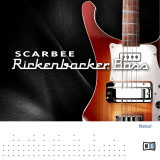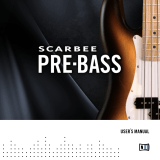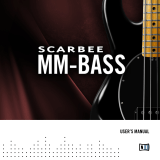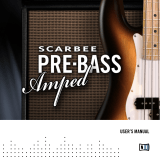Page is loading ...


Matthias Klag, Michael Ruf
Cristina Bachmann, Heiko Bischoff, Lillie Harris, Christina Kaboth, Insa Mingers, Matthias Obrecht, Sabine Pfeifer,
Benjamin Schütte, Marita Sladek
This PDF provides improved access for vision-impaired users. Please note that due to the complexity and number
of images in this document, it is not possible to include text descriptions of images.
The information in this document is subject to change without notice and does not represent a commitment on
the part of Steinberg Media Technologies GmbH. The software described by this document is subject to a License
Agreement and may not be copied to other media except as specically allowed in the License Agreement. No
part of this publication may be copied, reproduced, or otherwise transmitted or recorded, for any purpose,
without prior written permission by Steinberg Media Technologies GmbH. Registered licensees of the product
described herein may print one copy of this document for their personal use.
All product and company names are ™ or ® trademarks of their respective owners. For more information, please
visit www.steinberg.net/trademarks.
© Steinberg Media Technologies GmbH, 2019.
All rights reserved.
Electric Bass_1.0.0_en-US_2019-09-03

With Electric Bass, you can easily hand pick exactly the right bass sound that you need for your
song.
From soulful ’70s jams to classic jazz vibes to that big bass sound that can cut through every mix,
you can combine your bass sound with the included bass amp, a range of effects, and different
playing styles.
The window is divided into three sections: the parameter section on the left, the effects on the
right, and the fretboard in the lower part of the panel.
Parameter Section
This section provides parameters that allow you to shape the sound and control the playing
behavior of the bass. You can choose a pickup conguration, select a player, adjust Level and
Electric Bass
4

Tone. Here, you can dene how your playing on a keyboard is best translated into bass
articulations such as legato and slide, for example.
DI–Amp/FX
Allows you to set up the mix between the two busses that are used: DI and Amp/FX.
The DI bus delivers the pure dry signal of the bass.
The Amp/FX bus hosts the effects and bass ampliers.
Pickup
Allows you to select a pickup conguration. Electric Bass comes with a single coil
neck and a Humbucker bridge pickup that can also be used as separate single coil
pickups. This exible setup allows you to emulate the pickup congurations that can
be found on well-known classic electric bass models, but also delivers further
combinations to expand the sonic possibilities.
● J-Bass uses two single coil pickups, one in bridge and one in neck position.
● P-Bass uses one single coil pickup in neck position.
● MM-Bass uses one Humbucker pickup in bridge position.
● All Pickup uses all pickups combined.
● Neck Only uses one single coil pickup in neck position.
Compared to P-Bass, the behavior of the Tone control is slightly different.
● Bridge Only uses one single coil in bridge position.
● StereoRick uses two single coil pickups spread one to the left and one to the
right in the stereo signal.
Articulation
Electric Bass provides seven different articulations.
Articulations are saved in the program, that is, if you load a new program, the
Articulation setting can change.
● If the Sustain articulation is selected, the strings are played with ngers.
● If the Slap articulation is selected, the strings are slapped.
● If the Sustain Pick articulation is selected, the strings are played with a pick.
● If the Slap-Pull articulation is selected, the three lower strings (B, E, A) are
slapped and the upper two strings (D, G) are pulled.
● If the Mute articulation is selected, the strings are muted and played with
ngers.
Electric Bass
Parameter Section
5

● If the Articial Harmonics articulation is selected, harmonics are played on
pressed strings.
● If the Natural Harmonics articulation is selected, harmonics are played on
open strings.
NOTE
All harmonics of one string are mapped to the corresponding MIDI note and
distributed over the velocity range.
Player
Allows you to select a bass player. The available players differ mainly in the strategies
used to determine on which string and in which fret position a note is played, either
to minimize hand movement across the fret board or to create a more varied playing
style.
● The default Standard player moves to the nearest and best reachable position
on the fretboard for the next note.
● Avoid Open Strings is based on the same algorithm, however, this player
avoids playing open strings.
In addition, the following players are available:
● Blues
● Country
● Funk
● Jazz
● Metal
● Octaves
● Pop
● Rock
● R&B
● Walking Bass
These players are based on musical styles and the playing techniques used by
famous bass players of the genre.
Level
Adjusts the output level of the bass.
Tone
Allows you to shape the tone of the bass.
NOTE
The behavior of the Tone control depends on the Pickup parameter setting.
Ghost Notes
Activate this option to trigger ghost notes for lower velocities. The value eld on the
right allows you to specify the threshold for the ghost notes.
NOTE
Ghost notes are not available for the Mute, Natural Harmonics, and Articial
Harmonics articulations.
Electric Bass
Parameter Section
6

Options for the Sustain and Sustain Pick Articulations
For the sustain or sustain pick articulations, you can use automatic transitions that are used
when applicable.
Auto Legato
Activate this option to use legato transitions between consecutive notes that are
played legato.
When playing a real electric bass, legato is achieved not by plucking or picking a
string again, but either by placing another nger on the string (hammer on) or by
pulling the nger from the string while the note still plays (pull off). Both actions
must be distinct enough to trigger the new note. Auto Legato emulates this
behavior.
If you play legato notes and the rst note is still held when you release the second
note, the rst legato note is retriggered.
NOTE
Auto Legato is applied if the second note is within a range of 3 semitones and within
the current hand position.
Auto Slide
Activate this option to slide from one note to the next when playing notes legato.
NOTE
Auto Slide is applied if the second note is more than 3 semitones away and within
the current hand position.
NOTE
To force a slide between two notes, press B -1 on your MIDI keyboard before playing
the note. This works if it is physically possible to play a slide, that is, to stay on the
same string.
RELATED LINKS
Key switches on page 8
Settings Pane
The Settings pane allows you to make additional playback settings, such as fret noises, slide
speed, etc.
Click Show Settings to open the Settings pane.
Electric Bass
Parameter Section
7

Slide Speed A
Adjusts the slide speed for notes that are triggered with a velocity below 64.
Slide Speed B
Adjusts the slide speed for notes that are triggered with a velocity equal to and
above 64.
Pitchbend Range
Determines the range for the modulation that is applied when you move the
pitchbend wheel.
Release Level
Allows you to specify the level for the note-off samples that are triggered when a key
is released.
Ghost Notes Level
Allows you to specify the level for the ghost note samples.
NOTE
Ghost notes are played if the Ghost Notes option is activated in the parameter
section.
Fret Buzz Level
Sets the level of the fret buzz sounds. Fret buzz describes the sound that is produced
when a vibrating string hits a fret again. This does not happen all the time, but can
be used to add an additional touch of realism.
Fret Buzz Frequency
Determines how often a fret buzz sound is added.
Body Color Menu
To get the look and feel of the bass right, you can select a body color.
Open the Bass Body Color pop-up menu at the top right of the parameter section and select an
option from the menu. You can choose between four different colors.
Key switches
You can use various key switches to perform functions in Electric Bass, for example, to switch
between different articulations.
The keys on the internal keyboard are highlighted in different colors to indicate their different
uses.
Electric Bass
Key switches
8

Manual Control over the Played String
The green keys between C-1 and G-1 allow you to force incoming MIDI notes to be played on a
specic string.
● C-1 forces the note to be played on the B string.
● D-1 forces the note to be played on the E string.
● E-1 forces the note to be played on the A string.
● F-1 forces the note to be played on the D string.
● G-1 forces the note to be played on the G string.
When you press one of these key switches, you can see that the playable range on the keyboard
is updated accordingly to show that only this range can be used to play a MIDI note.
Hand Position Reset
A-1 allows you to reset the hand position for a player. This means that you can force the player to
come back to playing on lower frets after having moved up to higher hand positions, for
example.
Force Slide
To force a slide between two notes, press B -1 on your MIDI keyboard before playing the note.
NOTE
This works if it is physically possible to play a slide, that is, to stay on the same string.
Articulation key switches
The yellow keys between C0 and G0 trigger the articulations.
● C0 triggers the Sustain articulation.
● C#0 triggers the Slap articulation.
● D0 triggers the Sustain Pick articulation.
● D#0 triggers the Slap-Pull articulation.
● E0 triggers the Mute articulation.
● F0 triggers the Articial Harmonics articulation.
● G0 triggers the Natural Harmonics articulation.
Bass note trigger
With the black and white keys, you trigger the corresponding bass notes.
Slide Key Switches
The red keys between B4 and B6 contains various fret slides.
When these are played with a velocity below or equal to 64, you get a downwards slide. With
velocities above 64, you get upwards and downwards slides.
The slides are mapped chromatically, but they refer to the following open strings:
● B4 – D#5 contain slides on the B string.
Electric Bass
Key switches
9

● E5 – G#5 contain slides on the E string.
● A5 – C#6 contain slides on the A string.
● D6 – F#6 contain slides on the D string.
● G6 – B6 contain slides on the G string.
Effect Hit and Fret Noise Key Switches
The red keys between C7 and D#8 contain various effect hits and different fret noises.
● The keys between C7 and G#7 contain the effect hits.
● The keys between A7 and D#8 contain the fret noises.
Effects Section
The effects section allows you to send the bass signal to up to six stomp box effects and a virtual
amplier simulation.
The effect chain in the upper part of the effects section is where you select the effects that you
want to use and specify the order in which the bass signal travels through effects and bass
amplier.
To load an effect, click in the lower part of an effect slot and select an option from the pop-up
menu.
NOTE
An effect can only be used once in the effect chain.
The order in the effect chain denes the processing order of the effects. This has a great
inuence on the character of the sound. You can reorder the effects in the chain using drag and
drop.
To activate/deactivate an effect, click its FX On/Off button. This button can be found both in the
effect chain and in the effect editor.
If an effect is activated and selected in the effect chain, you can adjust its parameters in the lower
part of the effects section.
Electric Bass
Effects Section
10

Available Effects
You can choose between twelve different stomp box effects.
Graphic EQ
Graphic EQ is an equalizer with ten frequency bands that can be cut or boosted by up to 12 dB.
The Level control sets the overall output level of the equalizer.
Chorus
This effect thickens and broadens the sound by means of pitch modulation.
Sync
Activate this parameter to synchronize the effect to the host application. If Sync is
activated, you can set the Rate value in fractions of beats.
Rate
Allows you to specify the frequency of the pitch modulation in Hertz.
Width
Determines the depth of the chorus effect. Higher settings produce a more
pronounced effect.
Tone
Allows you to attenuate low frequencies.
Electric Bass
Effects Section
11

Mix
Sets the ratio between the dry and the wet signal.
Phaser
Sync
Activate this parameter to synchronize the effect to the host application. If Sync is
activated, you can set the Rate value in fractions of beats.
Rate
Allows you to set the sweep rate. This parameter can be synchronized to the project
tempo.
Width
Determines the width of the modulation effect between higher and lower
frequencies.
Tone
Allows you to attenuate the low frequencies.
Mix
Sets the ratio between the dry and the wet signal.
Flanger
Sync
Activate this parameter to synchronize the effect to the host application. If Sync is
activated, you can set the Rate value in fractions of beats.
Rate
Allows you to set the sweep rate. This parameter can be synchronized to the project
tempo.
Depth
Sets the intensity of the pitch modulation.
Feedback
Adds resonances to the effect. This allows for jet-like sweeps of the sound.
Tone
Adjusts the tone color of the feedback. At lower values, the feedback is less bright.
Mix
Sets the ratio between the dry and the wet signal.
Electric Bass
Effects Section
12

Overdrive
Overdrive creates a tube-like overdrive effect.
Drive
The higher this value, the more harmonics are added to the output signal of this
effect.
Tone
Works as a lter effect on the added harmonics.
Level
Adjusts the output level.
Octaver
Direct
Adjusts the level of the original signal. A value of 0 means only the generated and
transposed signal is heard. By raising this value, more of the original signal is heard.
Octave 1
Adjusts the level of the signal that is generated one octave below the original pitch. A
setting of 0 means that the voice is muted.
Tone
Changes the sound character of the generated signal.
Compressor
The Compressor reduces the dynamic range of a sound. This way, the sound gains headroom.
You can use this extra headroom to make the overall sound louder again.
Threshold
Sets the threshold. Sounds that are louder than the threshold are reduced in gain.
Sounds below the threshold stay untreated.
Electric Bass
Effects Section
13

Ratio
Sets the amount of gain reduction for sounds that are louder than the threshold. The
higher the ratio, the more the output is lowered. For example, if the ratio is set to 2:1
and the amplitude of the sound is 4 dB above the threshold, the output is lowered by
2 dB. If the amplitude is 8 dB above the threshold, the output is lowered by 4 dB.
Attack
Determines how fast the Compressor reacts to sounds that exceed the threshold.
The longer the attack time, the longer the time it takes to reduce the gain. With
longer attack times, the onset of sounds exceeding the threshold passes through
unprocessed.
Release
Determines how fast the Compressor effect reacts to sounds that fall below the set
threshold. The longer the release time, the longer it takes to return to the original
level.
DI Driver
Level
Sets the output level.
Blend
Blends between normal and tube emulation circuitry.
With Blend at 0, Drive and Presence are not active.
Bass
Boosts or attenuates low frequencies.
Treble
Boosts or attenuates high frequencies.
Presence
Boosts or attenuates upper frequencies and attacks.
Drive
Sets gain and overdrive.
Envelope Filter
Range
Determines the frequency range.
Electric Bass
Effects Section
14

Q-Factor
Sets the intensity of the envelope lter effect.
Sensitivity
Determines how sensitively the effect reacts to the instrument level.
Attack
Determines how quickly an effect reacts to the input signal.
Release
Determines how quickly the effect fades after the input signal stops.
Mix
Sets the ratio between the dry and the wet signal.
Type
Sets the lter type.
Tape Ducking Delay
Sync
Activate this parameter to synchronize the delay time to the host tempo. If Sync is
activated, you can set the Delay value in fractions of beats.
Delay
Sets the delay time in milliseconds.
Feedback
The higher this setting, the more delay repeats are created.
Duck
Works like an automatic mix parameter. If the level of the input signal is high, the
portion of the effect signal is lowered, or ducked (low internal mix value). If the level
of the input signal is low, the portion of the effect signal is raised (high internal mix
value). This way, the delayed signal stays rather dry during loud or intensely played
passages.
Tone
Allows you to attenuate the low frequencies.
Mix
Sets the ratio between the dry and the wet signal.
Reverb
This effect produces a high-quality algorithmic reverb with early reections and reverb tail.
Electric Bass
Effects Section
15

Room Size
Controls the dimensions of the simulated room. At a setting of 100 %, the
dimensions correspond to a cathedral or a large concert hall. At a setting of 50 %, the
dimensions correspond to a medium-sized room or studio. Settings below 50 %
simulate the dimensions of a small room or a booth.
Shape
Controls the attack of the reverb tail. At a setting of 0 %, the attack is more
immediate. The higher this value, the less immediate the attack.
Time
Controls the overall reverb time of the tail. The higher this value, the longer the
reverb tail will decay. At a setting of 100 %, the reverb time is innitely long.
ER/Tail
Sets the level balance between the early reections and the reverb tail. At a setting of
50 %, early reections and tail have the same volume. Settings below 50 % raise the
early reections and lower the tail. As a result, the sound source moves towards the
front of the room. Settings above 50 % raise the tail and lower the early reections,
and the sound source moves towards the back of the room.
Mix
Sets the ratio between the dry and the wet signal.
WahWah
Pedal
Controls the lter frequency sweep.
Bass Amplier
The bass amplier comes with six different amplier and four different speaker cabinet
emulations that can be freely combined.
Electric Bass
Effects Section
16

You can select your amplier/cabinet combination from the Amplier and Cabinet pop-up
menus.
Ampliers
The available ampliers are modeled on real-life ampliers. Each amp features settings typical
for bass recording, such as gain, equalizers, and master volume. The sound-related parameters
bass, low mid, high mid, and treble have a signicant impact on the overall character and sound
of the corresponding amp. Shape 1 and Shape 2 offer predened tone shaping.
Valve Amp 300
A famous tube amplier from the 70s, useful for rock playing styles.
Greyhound
An amplier, well known for its typical growl, useful for several playing styles.
Green T
A classic amplier from the 80s, useful for funk and rock playing styles.
Paradise
An amplier from the 90s, with a hi-like clear tone that makes it applicable for
several styles.
Tweed
A classic vintage amplier from the 50s, with a characterful and bright tone.
iTech
A modern amplier with a universal sound.
Cabinets
The cabinets available simulate real-life combo boxes or speakers.
4x10"
10" speakers provide a punchy, clear sound that is suitable for “Slap” bass and
regular playing styles.
10" speakers have a cleaner sound and more punch than 15" speakers.
8x10"
Double the amount of speakers compared to 4x10".
4x12"
12" speakers provide a mellow and full sound, making them a good choice between
10" and 15" speakers.
1x15"
15" speakers provide more low frequencies compared to the other cabinets. They are
suitable for rock and vintage-oriented styles.
Fretboard Section
The fretboard visualizes how the notes are played on the bass.
For each played note, an icon is shown at the corresponding fret position. The form of the icon is
determined by the articulation of the note. The red section on the fretboard indicates the
playable range covered by the current hand position of the player.
Electric Bass
Fretboard Section
17

The following icons are shown for the following articulations:
Icon
Articulation
Sustain or sustain pick notes
Muted notes
Harmonics notes
Legato notes
Slide notes
Slap notes
Pull notes
Electric Bass
Fretboard Section
18
/









